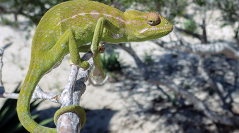

 Anthropozoologica
58 (1) - Pages 1-8
Anthropozoologica
58 (1) - Pages 1-8The Brooklyn snake papyrus (c. 380-343 BC) has intrigued Egyptologists since its publication in 1989. Thirty-seven of the 38 entries in the first half of the text describe individual snakes, as well as outline the physical effects of their bites, which has enabled the scientific identification of many to the species level. However, the identity of the last animal listed in the treatise, the kȝrȝ, is debated. The text describes the animal as green with three divisions on its head or back and possessing the ability to change colour, features that have suggested to many scholars that the kȝrȝ is a chameleon (Family Chamaeleonidae), but because these lizards are not dangerous to humans, its apparent association with venomous snakes has caused others to doubt this conclusion. Reference in the text to the creature possessing “two legs under it” has added to the confusion. Here I present information that has not been considered previously, which further supports the earlier identification of the kȝrȝ as a chameleon and explains why its grouping with snakes may have been considered logical according to the taxonomy used by the ancient Egyptians.
Ancient Egypt, lizards, folk taxomomies, animal behaviour.